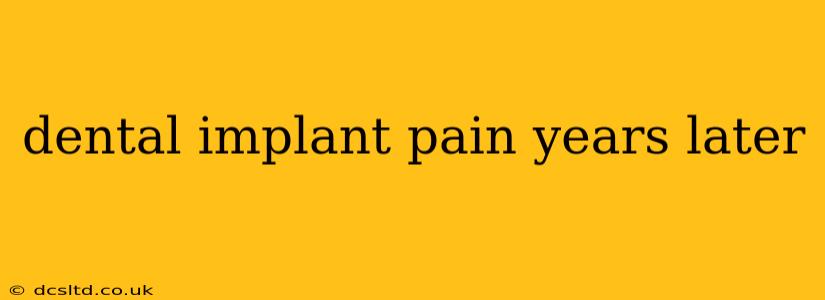Dental implants are a remarkable advancement in dentistry, offering a long-lasting solution for missing teeth. However, even with successful initial placement and integration, some individuals experience pain years after their implant procedure. This delayed onset of pain can be unsettling and warrants a thorough understanding of potential causes and treatment options. This comprehensive guide will explore the various reasons why you might experience dental implant pain years after the initial surgery, addressing common concerns and providing clarity on next steps.
Why Might I Experience Dental Implant Pain Years After the Procedure?
This is a crucial question, as the cause of delayed pain significantly impacts the treatment strategy. Several factors can contribute to pain years after dental implant placement:
Peri-implantitis: A Major Culprit
Peri-implantitis is a serious inflammatory condition affecting the tissues surrounding a dental implant. It's essentially the implant equivalent of periodontitis (gum disease) affecting natural teeth. While it can develop shortly after surgery, it can also manifest years later, leading to pain, bone loss, and even implant failure. Neglecting proper oral hygiene is a significant risk factor.
Osseointegration Issues: A Foundation Problem
Osseointegration refers to the successful bonding of the implant to the jawbone. While typically achieved within several months, occasional issues might surface years later. Incomplete osseointegration, or a weakening of this bond over time, can result in pain, loosening, and eventual implant failure. This is often related to underlying bone density or quality issues.
Infection: A Silent Threat
Even after the initial healing period, infection can still occur. Bacteria can enter the area around the implant, leading to inflammation and pain. This can be due to a variety of factors, including poor oral hygiene, trauma to the implant, or a pre-existing infection elsewhere in the mouth.
Sinus Issues (Upper Jaw Implants)
For implants placed in the upper jaw, proximity to the sinuses can create complications. Sinus infections or pressure changes can cause pain radiating to the implant area, even years after the procedure.
Bite Problems (Malocclusion)
An improper bite, or malocclusion, can put excessive stress on the implant and surrounding structures over time, resulting in pain. This can manifest years later as the supporting structures gradually wear down under the strain.
What are the Symptoms of Delayed Dental Implant Pain?
Recognizing the signs of delayed complications is crucial for prompt intervention. Symptoms can vary, but commonly include:
- Pain or soreness around the implant: This may be a dull ache, sharp pain, or throbbing sensation.
- Swelling or redness in the gums: Inflammation around the implant is a common indicator of a problem.
- Bleeding gums: Excessive bleeding during brushing or flossing can signal infection or inflammation.
- Loose implant: If the implant feels loose or wobbly, this is a serious sign requiring immediate attention.
- Changes in bite: Difficulty biting or chewing can indicate implant problems.
- Pus or discharge around the implant: This signifies an active infection.
What Should I Do if I Experience Pain?
If you are experiencing pain years after receiving a dental implant, do not delay in seeking professional help. Schedule an appointment with your dentist or periodontist. They will conduct a thorough examination, including X-rays, to determine the cause of your discomfort.
Diagnostic Procedures: Uncovering the Root Cause
Your dentist might utilize various diagnostic techniques, including:
- Clinical examination: A visual inspection and palpation to assess the implant and surrounding tissues.
- Radiographic imaging (X-rays): To evaluate the bone level, implant position, and presence of infection.
- Peri-implant probing: Measuring the depth of gum pockets around the implant to assess bone loss.
Treatment Options for Delayed Implant Pain
Treatment will vary depending on the underlying cause. Options include:
- Improved oral hygiene: For mild inflammation, improved brushing and flossing techniques, as well as the use of antimicrobial mouthwash, may be sufficient.
- Professional cleaning: Your dentist or hygienist can perform a deep cleaning to remove plaque and tartar buildup around the implant.
- Antibiotics: If an infection is present, antibiotics may be prescribed to clear the infection.
- Surgical intervention: In cases of advanced peri-implantitis or significant bone loss, surgical procedures might be necessary to clean the implant surface, regenerate bone, or even remove and replace the implant.
How Can I Prevent Future Problems?
Preventing delayed implant problems hinges on consistent and diligent aftercare:
- Maintain excellent oral hygiene: Brush and floss meticulously at least twice daily.
- Regular dental checkups: Attend regular checkups and professional cleanings.
- Avoid harmful habits: Refrain from smoking and limit excessive alcohol consumption.
- Report any unusual symptoms: Contact your dentist immediately if you experience any pain, swelling, or other unusual symptoms.
Delayed dental implant pain can be a concerning issue, but prompt diagnosis and treatment are crucial for preserving your implant and oral health. Remember, proactive care and regular dental checkups are essential for long-term success.
